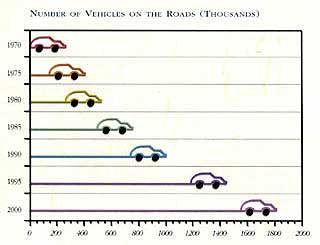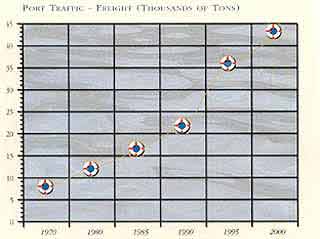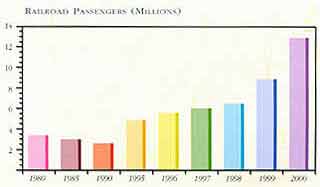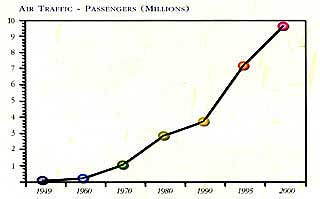Israel’s Transportation System
Although Israel is a very small country - some 470 kilometers (290 miles) long, and only 135 kilometers (85 miles) across at its widest point - it has a well-developed network of roads and railroads, as well as modern ports and airports. However, infrastructure development failed to keep pace with rapid population growth, boosted by the arrival of some one million immigrants over the last decade, and by a surge in economic growth and rising affluence. In response, much greater priority was given to investment in transport during the 1990s, and the government is now seeking to upgrade the transportation sector across the board, to introduce greater competition and to encourage private enterprise.
The Road Back
During the four centuries of Ottoman rule (1517-1917), a network of railway lines and some roads were built. Trains ran between the country's main cities as well as to Egypt, Syria and Lebanon. In addition, two ancient ports - in Jaffa and Acre - continued to be used as the link between Europe, Asia and Africa. During the British Mandate (1917-1948), the roads and railways were developed further, and a modern seaport and an airport were built.
The 1948 War of Independence left much of the transportation infrastructure damaged and railway lines cut off by borders. Thus in the early years of the new state, the fledgling government had to invest large sums in developing the transportation network. The needs of a population swelled by new immigrants from European and Arab countries required the financially pressed authorities to give infrastructure high priority. Haifa port was expanded, and a new harbor was developed on the country's southern Mediterranean coast in the new city of Ashdod. A new north-south railway line was constructed from Haifa to Be'er Sheva and Dimona. In addition, highways were built in the center of the country with branches to new communities in outlying regions.
In the early 1960s, rapid economic growth and the end to restrictions on importing private automobiles put a growing burden on the road network. But with especially heavy defense expenditures and the slowing of economic growth during the 1970s and 1980s, development in transportation infrastructure was often neglected. By the late 1980s, Israel's transportation network was in no position to accommodate the tidal wave of immigration from the former Soviet Union that would increase the population by 20 percent over the next decade.
Asphalt Jungle
Israel's road network extends more than 16,115 kilometers, including urban, access and non-urban roads. Modern highways radiate out of the major urban centers. But road infrastructure lags far behind the growth in the number of cars. There are now more than 1.8 million motor vehicles on the roads (more than one car for every four people), with a net increase of some 120,000 cars every year. As a result, an average of 105 cars crowd every kilometer of Israel's roads, compared to some 40 cars per kilometer in the U.S.
To help alleviate the congestion, funding for inter-urban road projects has increased substantially since 1992, with the Ministry of Transport's Public Works Department's annual budget exceeding $450 million in 1999 and 2000. Israel is also undertaking its biggest ever highway project, the Trans-Israel Highway. Construction began in 1992; it is planned to extend 300 kilometers from the northern border to the Negev. At a cost of $2 billion, it will form the eastern backbone of the country's transportation network, thereby reducing congestion and air pollution in the center of the country. The first phase of the highway - a 90-kilometer toll road running parallel to the greater Tel Aviv metropolitan area - is being constructed by an Israeli-Canadian consortium under a build-operate-transfer (BOT) method, in which the government appoints a private company to build and operate a project for a period of time, after which it transfers the assets back to the government. The toll road will cost around $750 million to build. The second phase will expand the highway by 48 kilometers north and south of phase one.
Another major BOT project is the Carmel Tunnel, a 16-kilometer underground road below Haifa's city center, linking the northern and southern side of the city. Like the Trans-Israel Highway, the Carmel Tunnel is aimed at alleviating congestion in the city center. The tender was won by a Spanish-Israeli consortium. Construction has been delayed due to difficulties in attaining necessary statutory building permits for the project.
Together with the building of new roads, the Ministry of Transport is also trying to coax Israelis out of their cars and onto buses. Israel's leading bus operator, Egged, carries one million passengers a day (see box). However, a 1998 study concluded that by 2020, it will be impossible to meet the growing demand on the roads by private cars. In response, the Ministry is increasing the number of bus-only routes within cities, toughening parking regulations in urban areas and encouraging residential and commercial construction close to major transport routes, so that workers can walk from public transportation to their houses and/or places of employment.

Source: Central Bureau of Statistics
By Air, By Sea
Government-owned El Al Israel Airlines made its inaugural flight in September 1948, bringing home the country's first president, Chaim Weizmann, from Geneva. El Al was formally established as the country's national airline the following year; since then, it has developed into a major international carrier with an all-Boeing fleet of 31 planes, including 10 Boeing 747s, three 777s, six 767s, seven 757s and five 737s. On order is another Boeing 777, due to be delivered in June 2002.
In 1999, El Al made a profit of $16 million, carrying over three million passengers on scheduled and charter flights. By the end of 2000, the airline had a permanent staff of 3,400 employees, but recorded a deficit of $109 million. The government currently owns 100 per cent of the company, but is planning its privatization. In addition to the main operation, El Al's Teshet subsidiary operates catering companies, cargo handling services at Ben Gurion International Airport, and the Laromme Hotel Chain. El Al's Sun D'or subsidiary operates charter flights between Israel and Europe.
Israel's domestic airline - Arkia Israel Airlines Limited - was jointly founded in 1950 by El Al Israel Airlines Ltd and Hevrat Haovdim of the Histadrut Labor Federation in order to provide an air link between the southernmost tourist town of Eilat and central Israel. In 1980 the company was privatized and purchased by Knaf Arkia Airlines. The parent company of Knaf Arkia, Knafaim, which was incorporated as the Arkia Group holding company, started trading in 1993 on the Tel Aviv Stock Exchange.
Arkia serves many destinations around the country, as well as operating charter flights to a number of European cities (including London, Paris, Berlin) and Mediterranean countries such as Corfu, Crete and Rhodes. Arkia also markets tour packages including flights, hotel accommodation, and excursions in Israel and to Jordan and Egypt.
Zim Israel Navigation, owned jointly by the government and Israel Corp., is the world's 10th-largest container shipping company. Zim was established in 1945 with a single passenger ship. The main task of the early years was to bring thousands of refugee- immigrants to Israel. In the late 1960s, as air travel grew and passenger lines were no activities but expanded its cargo lines.
Today, Zim operates a fleet of over 81 vessels, reaching every continent and calling at 265 ports worldwide. The company offers combined sea, land and air transportation services along most major international trading routes throughout the world.
Port of Call
For the first three decades of its existence, the State of Israel had no diplomatic or trade relations with its Arab neighbors. Even today, trade volumes with Egypt, Jordan and the Palestinian Authority are relatively small; almost 99 percent of exports are transported through three main seaports to countries abroad.
The country's oldest and largest seaport is Haifa Port, built by the British in the early 1930s. The port is located on the southern shore of Haifa Bay protected by two breakwaters, and boasts specialized terminals and modern equipment capable of handling containers of bulk cargo, chemicals and general cargo. The passenger terminal is linked to the city by an overhead bridge. During 1999, Haifa Port processed 17.2 million tons of cargo and 427,000 passengers.
Ashdod Port, further south on the Mediterranean coast, was opened in November 1965, replacing cargo operations in Tel Aviv and Jaffa some 40 kilometers to the north. The port was built as Israel's second Mediterranean deep-water port to handle cargo traffic for the central and southern parts of the country. Ashdod Port is one of the few deep-water ports in the world built on the open sea, which required engineers to overcome considerable design problems. Like Haifa, it is protected by two breakwaters and handles containers, bulk cargoes (coal, minerals and grain), general cargo and passengers. During 1999, 16.2 million tons of cargo and 167,000 passengers were processed at Ashdod Port.
Eilat Port is Israel's only non-Mediterranean harbor. It was opened for cargo traffic in 1957 to serve as the country's gateway to Africa, Asia and the Far East. Located at the southern tip of the country, this Red Sea port processed 1.7 million tons of cargo and 74 passenger ships in 1999.
Israel's Ports and Railways Authority is planning a massive expansion of the Haifa and Ashdod Ports, investing some $1 billion over the next six years as part of its 'Ports 2000' development plan. The Authority aims to increase port capacity, improve service and develop better road and railroad access. Haifa's facilities will be expanded through the development of the new Hacarmel Port, which is being constructed on the eastern side of the existing port. Completion is scheduled for the end of 2002. In Ashdod, the new Hayovel port is being constructed north of existing facilities, with the first stage also slated for completion in 2002.

Source: Central Bureau of Statistics
Making Tracks
The state-owned Israel Railways comprises some 570 kilometers of main lines and 336 kilometers of branch lines, with a fleet of 50 locomotives, 71 passenger cars, 24 DMUs (self-propelled passenger cars) and approximately 1,300 freight cars. More than 200 passenger trains a day travel throughout Israel - 43 between the north and Tel Aviv, 19 on the Tel Aviv-Rehovot route, 58 on the Netanya-Tel Aviv route and 18 on the Haifa-Nahariya route. The Petah Tikva-Rosh Ha'ayin route has 36 trains a day and is expected to double the number by next year; the same line is expected to continue to Kfar Sava at the end of next year. Israel Railways recently bought 14 double-decker trains from Bombardier and expects to increase its number of seats to 12,000 by the end of 2002 (from 8,600 today). In addition, over 100 freight trains operate daily. Israel Railways employs about 1,300 workers on a permanent and temporary basis.
Long a neglected part of Israel's transportation system, the passenger railway network is now the subject of a major government initiative to upgrade and expand infrastructure and improve service. To encourage commuters to take the train, the Ministry of Transport has started implementing a number of new projects. Existing railway lines - such as the Nahariya-Haifa-Tel Aviv line - are being improved, while new lines - such as the Tel Aviv-Be'er Sheva line - are being inaugurated. The effort has already begun to yield results. In 2000, some 13 million passengers traveled by train, up from nine million in 1999 and 5.5 million in 1996. In the next five years the number is expected to reach 40 million. The Ministry is also considering reopening the scenic but slow and meandering Tel Aviv-Jerusalem line and linking it to Ben-Gurion International Airport.
In addition, light-rail projects are planned within Israel's major cities. The most advanced is the $300-$400 million Jerusalem light railway project, which will be run on a BOT basis over 30 years. A much larger scheme is the Tel Aviv light railway project, which will include underground segments in the busiest parts of the city and is estimated to cost $1.5 billion. Two additional light railways are planned for Haifa and Be'er Sheva. The Haifa project is expected to cost approximately $1 billion and will include a 23-kilometer line that will be integrated with bus and suburban railroad systems and a planned $25 million cable car.

Source: Central Bureau of Statistics
Upward Expansion
Israel has one major international airport - Ben-Gurion International - which was opened in 1936 by the British as Lydda Airport (its name was changed to Ben-Gurion International in 1974). A smaller airport serves the southernmost resort town of Eilat. In addition, there is a network of smaller airfields in the major cities (Tel Aviv and Haifa) and smaller towns for domestic flights.
Around 10 million travelers passed through Ben-Gurion Airport in 2000. In order to handle the growing traffic of passengers, the Israel Airports Authority has begun a $600 million expansion project at Ben-Gurion Airport, one of the biggest government-funded infrastructure projects ever undertaken. The centerpiece is a new 270,000 square meter passenger terminal with a capacity for 16 million passengers annually, which will be accessed by improved rail and road links. The project is being financed mainly by the government, the remainder by businesses which will run the commercial activities at the airport. American and Israeli architects are involved in the terminal's design, with international and local companies advising on all stages of the planning and development of the project.

Source: Central Bureau of Statistics
Take the Bus
When Israelis aren't driving, their preferred mode of transportation is the bus. Even though it serves a population of just over six million people, Egged Israel Transport Cooperative Society Ltd. is the second-largest bus operator in the world, after London Transport. Organized as a cooperative, Egged has 3,250 members and 4,550 salaried employees, operating 4,000 buses on thousands of scheduled routes as well as special trips. Egged carries around one million passengers every day.
The first public buses appeared in the country after the First World War, fashioned from converted trucks. Bus drivers gradually united into cooperatives that reflected their social ideals of freedom, independence, productive labor, mutual aid and equality. Each member had an equal standing and say in management. Egged itself was founded in 1933 in a merger of four smaller bus cooperatives. Its name, which means "linked together," was proposed by the national poet Hayim Nahman Bialik, and was intended to express the close bond between the cooperative's members. Egged began its operations by offering regular routes from Tel Aviv to Jerusalem and Haifa, as well as to communities along these routes. Until the establishment of the State in 1948, it also operated a scheduled service to Lebanon, Syria, Iraq, Trans-Jordan and Egypt.
Today, Egged provides 70 pecent of Israel's public transport; the Dan cooperative, operating in the greater Tel Aviv area, supplies most of the balance. Egged works on the basis of a government license renewed automatically every year, with the government setting fares and conditions. The cooperative's annual turnover is about $600 million.
Egged is facing a number of challenges as public demand and transportation policy change. Since 1991, the number of bus travelers has fallen by two percent, as more commuters take to their cars. Meanwhile, the government has begun to chip away at Egged's monopoly. In 1999 it decided to open eight percent of Egged's routes to competition among private operators, awarded through tenders. An additional 25 percent of Egged's lines will be tendered by 2009. The government also wants to privatize Egged by floating shares and/or selling a stake to investors.
To meet the challenges of competition, Egged is expanding into new areas. The company has set up a subsidiary to run a VIP transportation service, and is studying the possibility of starting a domestic airline service and running a hydrofoil service between coastal cities. In addition, older members of the cooperative are being offered early retirement packages, and the workforce has been trimmed from 10,280 in 1989 to 7,800 today. Egged has also begun rapid bus transit services that will provide an alternative to the planned light railways in Jerusalem and Haifa.
Israeli Foreign Ministry

